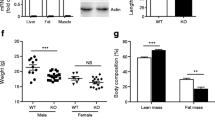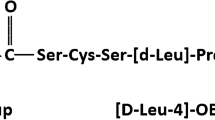Abstract
Background
Obesity, the condition of excessive accumulation of fat is a poorly understood disorder and is a risk factor for type II diabetes, hypertension, and hyperlipidaemia. Recently, a putative mouse obese gene was cloned and its product, termed ob protein, was shown to be involved in the regulation of body weight.
Materials and Methods
Bacterial and insect cells were used for expression of recombinant mouse ob protein. Amino-terminal sequence analysis and site-directed mutagenesis were used to identify and characterize the mature form of ob protein. Genetically obese mice and wild-type rats were used to determine the biological activity of ob protein.
Results
Mouse ob protein is synthesized as a precursor molecule, the mature form of which was found in mouse serum. Biochemical analysis identified the processing site in the ob precursor molecule and an intramolecular disulfide bond in the mature form that is necessary for activity. Reduction of food intake and weight gain after administration of ob protein to genetically obese mice and wild-type rats is reversible.
Discussion
This study demonstrates that ob protein is a secreted satiety factor which regulates body weight and reduces food intake even in animals with no genetic body weight abnormalities. The failure of ob protein to effect these parameters in db/db mice supports the hypothesis that these mice are deficient in a signaling molecule that normally responds to the ob protein.





Similar content being viewed by others
References
Bray BA, York DA. (1979) Hypothalamic and genetic obesity in experimental animals: An autonomic and endocrine hypothesis. Physiol Rev. 59: 719–809.
Friedman JM, Leibel RL. (1992) Tackling a weighty problem. Cell 69: 217–220.
Grundy SH, Barnett JP. (1990) Metabolic and health complications of obesity. Disease-a-Month 36: 645–696.
Harris MI, Hadden WC, Knowler WC, Bennett PH. (1987) Prevalence of diabetes and impaired glucose tolerance and plasma glucose levels in U.S. population aged 20–74 yr. Diabetes 36: 523–534.
Woods SC, Gibbs J. (1989) The regulation of food intake by peptides. Ann. NY Acad. Sci. 575: 236–243.
Bray GA, York DA, Fisler JS. (1989) Experimental obesity: A homeostatic failure due to defective nutrient stimulation of the sympathetic nervous system. Vitam. Horm. 45: 1–125.
Maffei M, Fei H, Lee G-H, et al. (1995) Increased expression in adipocytes of ob RNA in mice with lesions of the hypothalamus and with mutations at the db locus. Proc. Acad. Natl. Acad. USA 92: 6957–6960.
Coleman DL. (1973) Effects of parabiosis of obese with diabetes and normal mice. Diabe-tologia 9: 294–298.
Coleman DL. (1978) Obese and diabetes: Two mutant genes causing diabetes-obesity syndromes in mice. Diabetologia 14: 141–148.
Zhang Y, Proenca R, Maffei M, Barone M, Leopold L, Friedman JM. (1994) Positional cloning of the mouse obese gene and its human homologue. Nature 372: 425–432.
Naggert JK, Fricker LD, Varlamov O, et al. (1995) Hyperproinsulinaemia in obese fatlfat mice associated with a carboxypeptidase E mutation which reduces enzyme activity. Nature Genet. 10: 135–142.
Rink TJ. (1994) In search of a satiety factor. Nature 372: 406–407.
Coleman DL, Hummel KP. (1969) Effects of parabiosis of normal with genetically diabetic mice. Am. J. Physiol. 217: 1298–1304.
Pellymounter MA, Cullen MJ, Baker MB, et al. (1995) Effects of the obese gene product on body weight regulation in oblob mice. Science 269: 540–543.
Halaas JL, Gajiwala KS, Maffei M, et al. (1995) Weight-reducing effects of the plasma protein encoded by the obese gene. Science 269: 543–546.
Campfield LA, Smith FJ, Guisez Y, Devos R, Burn P. (1995) Recombinant mouse ob protein: Evidence for a peripheral signal linking adiposity and central neural networks. Science 269: 546–549.
Studier F, Rosenberg A, Dunn J, Dubendorff J. (1990) Use of T7 RNA polymerase to direct expression of cloned genes. Methods Enzymol. 185: 60–89.
Matthias P, Mueller M, Schreiber E, Rusconi S, Schaffner W. (1989) Eukaryotic expression vectors for the analysis of mutant proteins. Nucleic Acids Res. 17: 6418–6418.
Grosschedl R, Baltimore D. (1985) Cell-type specificity of immunoglobulin gene expression is regulated by at least three DNA sequence elements. Cell 41: 885–897.
Munemitsu S, Innis MA, Clark R, McCormick F, Ullrich A, Polakis P. (1990) Molecular cloning and expression of a G25K cDNA, the human homolog of the yeast cell cycle gene CDC42. Mol. Cell. Biol. 10: 5977–5982.
Kitts PA, Ayres MD, Possee RD. (1990) Linearization of baculovirus DNA enhances the recovery of recombinant expression virus. Nucleic Acids Res. 18: 5667–5672.
Smith GA, Summers MD, Fraser MJ. (1983) Production of human interferon in insect cells infected with a baculovirus expression vector. Mol. Cell. Biol. 3: 2156–2165.
Maiorella B, Inlow D, Shauger A, Harano D. (1988) Large-scale insect cell-culture for recombinant protein production. Biotechnology 6: 1406–1510.
Giese K, Grosschedl R. (1993) LEF-1 contains an activation domain that stimulates transcription only in a specific context of factor-binding sites. EMBO J. 12:4667–4676.
O’Reilly DR, Miller LK, Luckow VA. (1992) Baculovirus Expression Vectors: A Laboratory. Freeman and Company, New York.
Wetzel R. (1992) Principles of protein stability. In: Rees AR, Sternberg MJE, Wetzel R (eds). Protein Engineering. A Practical Approach. IRL Press, Oxford.
Acknowledgments
The authors thank Ross Okamura (UCSF) for mouse fat tissue, Jon Strich, Frank Marcus, and Bob Drummond for help in protein production and purification, and Frank Masur and Surinder Kaur for mass spectroscopy and N-terminal sequence analysis. We thank Leah Conroy for expert assistance in growth of insect cells. We also thank Laurie Stephens, Mike Cardone, Filippo Randazzo, David Duhl, and Jaime Escobedo for helpful discussions.
Author information
Authors and Affiliations
Additional information
Contributed by F. E. Cohen Cohen on September 21, 1995.
Rights and permissions
About this article
Cite this article
Giese, K., Fantl, W.J., Vitt, C. et al. Reduction of Food Intake and Weight Gain by the ob Protein Requires a Specific Secondary Structure and Is Reversible. Mol Med 2, 50–58 (1996). https://doi.org/10.1007/BF03402202
Published:
Issue Date:
DOI: https://doi.org/10.1007/BF03402202




